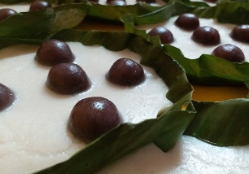ARTS AND CULTURE INFORMATION GATEWAY
Immerse yourself in the colorful world of art and culture! From traditional heritage to contemporary works, discover uniqueness that reflects the nation's identity and identity
KUIH BADAK KUBANG
Picture
1
Video
No record
Today's Visitor
16
Number of Visitors
317
Introduction and history
-
-
Outer Layer (Skin):
2 cups glutinous rice (soaked for 2-3 hours)
1 cup grated coconut (for the outer coating)
Banana leaves (for wrapping the kuih)
Filling (Inti):
1 cup palm sugar (gula melaka) (finely sliced)
1/2 cup grated coconut (for the filling)
1 teaspoon salt
1/2 cup water
Prepare the Palm Sugar Filling:
Combine palm sugar (gula melaka), grated coconut, and salt in a pan.
Gradually add water while stirring until the palm sugar dissolves and the mixture thickens.
Cook over low heat until the filling becomes slightly sticky and easy to shape. Remove from heat and set aside to cool.
Prepare the Glutinous Rice:
Wash the soaked glutinous rice and drain it well.
Steam the glutinous rice in a steamer for about 20-30 minutes until fully cooked. Ensure the rice is spread in an even layer for uniform cooking.
Shaping the Kuih:
Take a small amount of steamed glutinous rice and place a bit of grated coconut on top.
Add a small portion of palm sugar filling in the center.
Shape the glutinous rice around the filling, forming a round ball.
Wrap each glutinous rice ball with banana leaves and secure it with string or toothpicks to maintain its shape.
Steaming the Kuih:
Steam the wrapped kuih in banana leaves for 20-30 minutes until fully cooked and aromatic.
Ensure the heat is not too high and steam at a moderate temperature to cook evenly.
Serving:
Once steamed, Kuih Badak Kubang can be served warm or at room temperature. You can sprinkle additional grated coconut on the kuih as a garnish or serve it in its traditional wrapped form.
Tips:
Ensure the glutinous rice is well-steamed for a soft and chewy texture.
Use fresh and clean banana leaves for wrapping to enhance the aroma and authentic taste.
If desired, add a small amount of food coloring to the glutinous rice for a more vibrant appearance.
-
Reference Source
i. Bahan Bacaan
Abdullah, M. Z. (2005). Makanan Tradisional Melayu: Resipi dan Sejarah. Kuala Lumpur: Dewan Bahasa dan Pustaka.
Hassan, N. (2010). Kuih Tradisional Malaysia: Warisan Rasa dan Budaya. Kuala Lumpur: Penerbit Universiti Malaya.
Location
State JKKN Contact Information
Puan Norlelah Abd Karim
Cultural Officer
Jabatan Kebudayaan dan Kesenian Negara, Pahang
Kompleks JKKN Pahang
Lot 57100, Jalan Teluk Sisek,
25000, Kuantan,
Pahang Darul Makmur
09-517 8466
Use the form below to contact the Informant/Figure/Editor/Researcher directly. We will respond to your inquiry as soon as possible!









